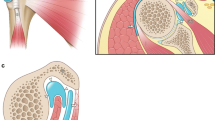Abstract
The omental bursa is a complex and important anatomical region. It serves as a barrier to block pathological processes, but it is also a channel for disease spread in the abdominal cavity. It is a large recess of the peritoneal cavity formed by a double-layered fold of serous peritoneum situated inferiorly to the liver, posteriorly to the lesser omentum and the stomach and anteriorly to the pancreas. Ultrasound (US) has an important role in the study of the omental bursa, as it is generally the first examination to be performed in the presence of abdominal pain. US is inexpensive, widely available and able to identify many of the alterations that may occur in the abdomen. However, US findings are often varied and unspecific, ranging from fluid collections to diffuse infiltration. Familiarity with the various diseases that may affect the omental bursa is essential in order to be able to identify them during US examination of the abdomen. US imaging is useful in the follow-up after treatment and to guide drainage of fluid collections.
Riassunto
La borsa omentale è una regione anatomica complessa e importante; funge da barriera per contenere processi patologici, ma anche da via per la diffusione di malattie nella cavità addominale. Essa è un ampio recesso della cavità peritoneale, costituito da una riflessione a doppio strato di sierosa peritoneale, localizzato al di sotto del fegato, posteriormente al piccolo omento e allo stomaco e anteriormente al pancreas. L’ecografia può avere un ruolo importante nello studio della retrocavità degli epiploon, essendo spesso il primo esame in presenza di dolore addominale, relativamente poco costoso, facilmente accessibile e in grado di identificare molte delle alterazioni che possono manifestarsi in tale sede, anche se spesso con segni piuttosto vari e non specifici, che vanno dalla raccolta liquida alla diffusa infiltrazione. La conoscenza delle diverse patologie della retrocavità degli epiploon è fondamentale per il loro riconoscimento durante lo studio ecografico dell’addome; l’ecografia può poi essere usata nel follow-up e come guida per il drenaggio di raccolte.




Similar content being viewed by others
References
Tirkes T, Sandrasegaran K et al (2012) Peritoneal and retroperitoneal anatomy and its relevance for cross-sectional Imaging. Radiographics 32:437–451
Yoo E, Kim H et al (2007) Greater and lesser omenta: normal anatomy and pathologic processes. Radiographics 27:707–720
Oliphant M, Berne AS, Meyers MA (1996) The subperitoneal space of the abdomen and pelvis: planes of continuity. AJR Am J Roentgenol 167(6):1433–1439
Hanbidge AE, Lynch D, Wilson SR (2003) US of the peritoneum. Radiographics 23(3):663–684 (review)
Fabbri C, Luigiano C et al (2012) Endoscopic ultrasound-guided drainage of pancreatic fluid collections. World J Gastrointest Endosc 4(11):479–488. doi:10.4253/wjge.v4.i11.479
Ruess L, Frazier AA, Sivit CJ (1995) CT of the mesentery, omentum, and peritoneum in children. Radiographics 15(1):89–104 (review)
Conflict of interest
S. Alessi, C. Bortolotto and L. Carone declare that they have no conflict of interest related to this article.
Informed consent
No patient information was included in this study. However, the authors have the patients’ consent to the publication of images that could potentially lead to their identification.
Human and animal studies
In connection with this article, the authors did not carry out any procedures involving humans or animals.
Author information
Authors and Affiliations
Corresponding author
Rights and permissions
About this article
Cite this article
Alessi, S., Bortolotto, C. & Carone, L. Ultrasound findings in the omental bursa: a short pictorial essay. J Ultrasound 18, 63–66 (2015). https://doi.org/10.1007/s40477-013-0038-5
Received:
Accepted:
Published:
Issue Date:
DOI: https://doi.org/10.1007/s40477-013-0038-5




